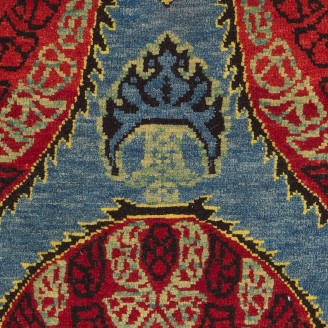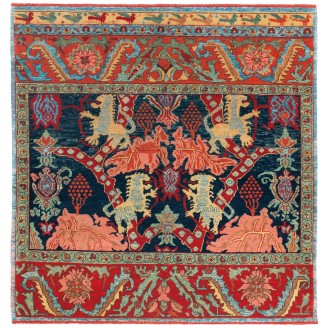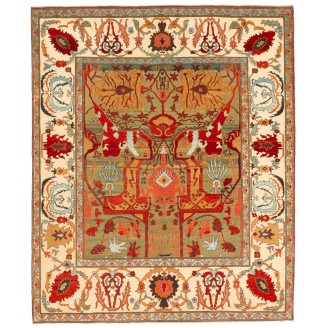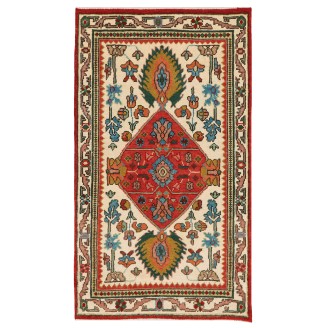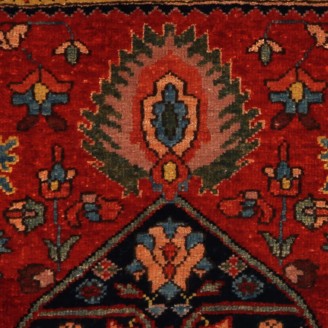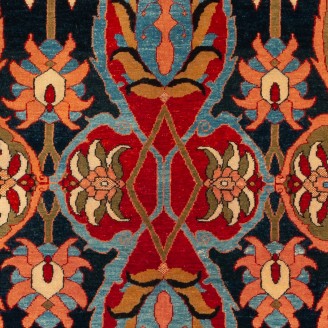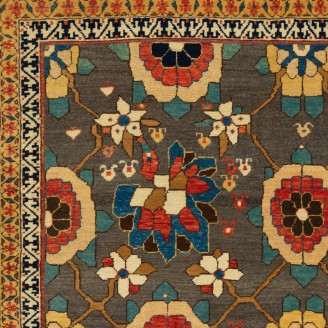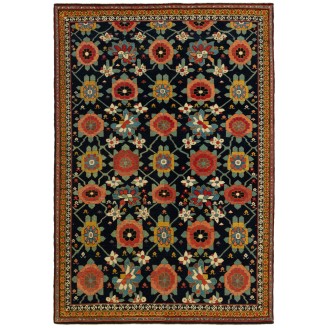COLLECTION OF BIDJAR RUGS
Roof of Iran. Showcases the exquisite artistry and durability of Persian weaving
Model: ART00127
Dimensions: 1'10" X 2'7"(58cm x 80cm)
The most dramatic of the Gerous ( Garrus, Gerus, Garus ) carpets are those with an "asymmetric" design. Only a section of the original is shown, in the same way, many Lotto carpets were woven. It is difficult to guess the size of these carpets from a photo, but here we enter the area of the "Wagireh..
Price:
$825
Ex Tax:$825
Model: ART00476
Dimensions: 4'10" X 7'8"(149cm x 235cm)
The source of the rug comes from the book Antique Rugs of Kurdistan A Historical Legacy of Woven Art, James D. Burns, 2002 nr.45. This is a popular design employed by the Kurds, called bid majnum (or Bid Majnun, weeping willow) 17th-century rug from Sa'uj Bulagh, Eastern Kurdistan area. Four differe..
Price:
$6,500
Ex Tax:$6,500
Model: ART00070
Dimensions: 1'9" X 3'5"(54cm x 105cm)
This offset pattern is composed of leaves and lotus palmettes filling the various compartments against the imposing ground, while heraldic lions rear across the strapwork borders. One has the impression that it is only part of a larger scheme designed 19th-century rug from Bidjar region, Eastern Kur..
Price:
$650
Ex Tax:$650
Model: ART00067
Dimensions: 1'6" X 2'5"(47cm x 75cm)
This offset pattern is composed of leaves and lotus palmettes filling the various compartments against the imposing ground, while heraldic lions rear across the strapwork borders. One has the impression that it is only part of a larger scheme designed 19th-century rug from Bidjar region, Eastern Kur..
Price:
$950
Ex Tax:$950
Model: ART00068
Dimensions: 1'9" X 3'4"(54cm x 104cm)
This offset pattern is composed of leaves and lotus palmettes filling the various compartments against the imposing ground, while heraldic lions rear across the strapwork borders. One has the impression that it is only part of a larger scheme designed 19th-century rug from Bidjar region, Eastern Kur..
Price:
$550
Ex Tax:$550
Model: ART00021
Dimensions: 3'6" X 3'8"(109cm x 113cm)
This offset pattern is composed of leaves and lotus palmettes filling the various compartments against the imposing ground, while heraldic lions rear across the strapwork borders. One has the impression that it is only part of a larger scheme designed 19th-century rug from Bidjar region, Eastern Kur..
Price:
$3,450
Ex Tax:$3,450
Model: ART00100
Dimensions: 1'8" X 2'9"(52cm x 85cm)
This offset pattern is composed of leaves and lotus palmettes filling the various compartments against the imposing ground, while heraldic lions rear across the strapwork borders. One has the impression that it is only part of a larger scheme designed 19th-century rug from Bidjar region, Eastern Kur..
Price:
$500
Ex Tax:$500
Model: ARTK0009
Dimensions: 3'6" X 3'8"(109cm x 113cm)
This offset pattern is composed of leaves and lotus palmettes filling the various compartments against the imposing ground, while heraldic lions rear across the strapwork borders. One has the impression that it is only part of a larger scheme designed 19th-century rug from Bidjar region, Eastern Kur..
Price:
$0
Ex Tax:$0
Model: ART00488
Dimensions: 4'9" X 7'6"(145cm x 230cm)
The source of the rug comes from the book Islamic Carpets, Joseph V. McMullan, Near Eastern Art Research Center Inc., New York 1965 nr.28. This Persian Garden design rug belongs to the second half 18th century in the Persia area. The design of this rug is based on the Formal Persian Garden. There is..
Price:
$7,800
Ex Tax:$7,800
Model: ARTK0007
Dimensions: 9'2" X 5'11"(280cm x 182cm)
This is a central medallion with connected palmette and flowers designed carpet 19th century from Garrus ( Gerous or Garus ) region, Eastern Kurdistan area. Garrus is located in the foothills approaching the flatlands of Persia, Garrus has been a significant Kurdish city since antiquity when it was ..
Price:
$0
Ex Tax:$0
Model: ART00432
Dimensions: 6'6" X 9'10"(200cm x 300cm)
The source of the rug comes from the book Islamic Carpets, Joseph V. McMullan, Near Eastern Art Research Center Inc., New York 1965 nr.22. This is a system of arabesque-designed 19th-century rugs from Gerous ( Garrus or Garus ) region, Eastern Kurdistan area. This rug is a splendid echo of the Arabe..
Price:
$12,500
Ex Tax:$12,500
Model: ARTK0006
Dimensions: 4'5" X 7'5"(136cm x 228cm)
The source of the rug comes from the book Islamic Carpets, Joseph V. McMullan, Near Eastern Art Research Center Inc., New York 1965 nr.22. This is a system of arabesque-designed 19th-century rugs from Gerous ( Garrus or Garus ) region, Eastern Kurdistan area. This rug is a splendid echo of the Arabe..
Price:
$0
Ex Tax:$0
Model: ART00221
Dimensions: 6'2" X 7'5"(188cm x 227cm)
The source of the rug comes from the book Islamic Carpets, Joseph V. McMullan, Near Eastern Art Research Center Inc., New York 1965 nr.22. This is a system of arabesque-designed 19th-century rugs from Gerous ( Garrus or Garus ) region, Eastern Kurdistan area. This rug is a splendid echo of the Arabe..
Price:
$7,900
Ex Tax:$7,900
Model: ART00245
Dimensions: 3'3" X 5'6"(101cm x 170cm)
The source of the rug comes from the book Islamic Carpets, Joseph V. McMullan, Near Eastern Art Research Center Inc., New York 1965 nr.22. This is a system of arabesque-designed 19th-century rugs from Gerous ( Garrus or Garus ) region, Eastern Kurdistan area. This rug is a splendid echo of the Arabe..
Price:
$4,500
Ex Tax:$4,500
Model: ART00071
Dimensions: 1'9" X 3'1"(54cm x 95cm)
The most dramatic of the Gerous ( Garrus, Gerus, Garus ) carpets are those with an "asymmetric" design. Only a section of the original is shown, in the same way, many Lotto carpets were woven. It is difficult to guess the size of these carpets from a photo, but here we enter the area of the "Wagireh..
Price:
$825
Ex Tax:$825
Model: ART00063
Dimensions: 1'7" X 2'3"(50cm x 70cm)
The most dramatic of the Gerous ( Garrus, Gerus, Garus ) carpets are those with an "asymmetric" design. Only a section of the original is shown, in the same way, many Lotto carpets were woven. It is difficult to guess the size of these carpets from a photo, but here we enter the area of the "Wagireh..
Price:
$825
Ex Tax:$825
Model: ART00072
Dimensions: 1'8" X 2'10"(53cm x 88cm)
The most dramatic of the Gerous ( Garrus, Gerus, Garus ) carpets are those with an "asymmetric" design. Only a section of the original is shown, in the same way, many Lotto carpets were woven. It is difficult to guess the size of these carpets from a photo, but here we enter the area of the "Wagireh..
Price:
$0
Ex Tax:$0
Model: ART00246
Dimensions: 3'6" X 5'8"(108cm x 174cm)
The most dramatic of the Gerous ( Garrus, Gerus, Garus ) carpets are those with an "asymmetric" design. Only a section of the original is shown, in the same way, many Lotto carpets were woven. It is difficult to guess the size of these carpets from a photo, but here we enter the area of the "Wagireh..
Price:
$3,500
Ex Tax:$3,500
Model: ART00508
Dimensions: 4'8" X 7'1"(143cm x 217cm)
The source of the rug comes from the book Antique Rugs of Kurdistan A Historical Legacy of Woven Art, James D. Burns, 2002 nr.4. This was an exclusive example of a Mina Khani lattice design mid-19th century rug from Koliya'i, Southern Kurdistan area. The mina khani is composed of a series of rows of..
Price:
$6,200
Ex Tax:$6,200
Model: ART00562
Dimensions: 5'8" X 8'3"(174cm x 253cm)
The source of the rug comes from the book Antique Rugs of Kurdistan A Historical Legacy of Woven Art, James D. Burns, 2002 nr.4. This was an exclusive example of a Mina Khani lattice design mid-19th century rug from Koliya'i, Southern Kurdistan area. The mina khani is composed of a series of rows of..
Price:
$8,900
Ex Tax:$8,900
Model: ART00454
Dimensions: 2'9" X 5'6"(84cm x 170cm)
The source of the rug comes from the book Antique Rugs of Kurdistan A Historical Legacy of Woven Art, James D. Burns, 2002 nr.4. This was an exclusive example of a Mina Khani lattice design mid-19th century rug from Koliya'i, Southern Kurdistan area. The mina khani is composed of a series of rows of..
Price:
$2,300
Ex Tax:$2,300

